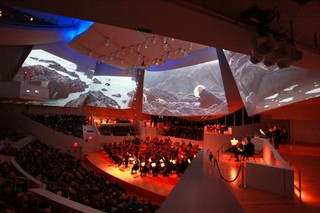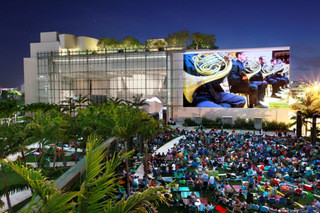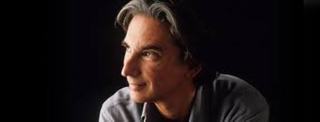|
Back
The New World Symphony (Part 2)
03/30/2015

Inside New World Center (© Rui Dias Aidos)
This is the second piece on the New World Symphony, which will be in Carnegie Hall on April 28 with Anne-Sophie Mutter and their founder and conductor, Michael Tilson Thomas.
******************************************
Nobody calls the players of the New World Symphony either students or musicians. They are “Fellows”. In the academic sense, this means that these musicians are like graduate students, who literally play for their supper. In the sense of the New World Symphony, the 80-odd players who attend for three years, enjoy (and endure) orchestral excperiences rarely considered essential in most conservatories.
Philip Kennicott of the Washington Post called New World Symphony “one of the most innovative organizations in the country”, and the skills they hone are obviously unique.
Chosen from international auditions–over 1,500 conservatory graduates audition for 35 spots each year–they are amongst their 20-ish-year-old colleagues who have gained enormous personal skill in their instruments, but lack the experience of playing in full symphony orchestras outside their conservatories.
Here, they are able to practice, rehearse and finally perform in one of the more dynamic concert halls in the United States, created especially for their skills, by Frank Gehry, and New World Symphony conductor Michael Tilson Thomas (see New World Symphony Part 1).
In addition to artistic director Michael Tilson Thomas, guest conductors in recent years have included Paavo Järvi, Neville Marriner, Oliver Knussen, David Robertson and Mark Wigglesworth. They also accompany such stellar performers as Anne-Sophie Mutter, who will play the Berg Violin Concerto in their Carnegie Hall concert on April 28.
Not only do they play the usual mainstream music, but composers in the most varied fields have written for them. At one performance I attended, the pop giant Bruce Hornsby played, sung and had orchestrated three songs; Ted Hearne had a world premiere of his work. And the amazing duo of Michael Gordon and video artist Bill Morrison took advantage of the projection wings of the concert hall for a work commissioned by Miami Beach itself to celebrate its centenary as a city.
And while Michael Tilson Thomas introduced the concert, he left the conducting to one of the Fellows, in this case Christian Reif.
How does one describe this “innovative” group. Officially, it is called “America’s Orchestral Academy”, though this sounds rather dry. The Chairman of the New World Symphony Board of Directors, Rose Ellen Greene, describes it better:
“The heart and soul of the institution addresses three areas of study: orchestral performance and musicianship, community engagement and leadership.” In more detail, she says, “The results of the performances come from hours of individual practice and in-depth study of their chosen repertoire guided by visiting faculty from major orchestras across the United State, South America and Europe.”
That is the musical part of it. The “community engagement” includes teaching in public schools and private lessons to those in Miami–a city of so apparent wealth and poverty–for those who can’t afford lessons. They also work with video artists, lighting and sound technicians, and the most singular program developers.
As to the latter, the New World Symphony attracts big crowds to their outdoor performances by special programs like “Yoga Night” and Cycling Night.
(And what music do you use for Yoga? New World Symphony played from a Bach Cello Suite, Philip Glass’ Glassworks, and Beethoven’s ”Moonlight” Sonata. For “Cycling Night”, a more energetic program: Wagner’s Ride of the Valkyries, a Mahler symphony finale, Bernstein’s Candide overture, Gliere’s Russian Sailor’s Dance and Flight of the Bumblebee, the latter of which I am extremely happy not to bike with).
The Academy also has the use of MUSAIC, a closed-channel Internet2 video channel where they can communicate with musicians around America and the world. On the one hand, Fellows can ask First Chair players about technical problems with their own instruments. But they can also inquire about more general matters regarding orchestral playing.

Outside Wallcast (© Rui Dias Aidos)
Typical was a conversation with Thomas Hooten, Principal Trumpet of the Los Angeles Symphony Orchestra. Subjects from the Fellows included priorities about auditions. They want to know the differences between auditioning as a section leader or a section member; how to get feedback from committees for successful (and unsuccessful) auditions; how to relate, before and after, a meeting with an audition committee.
To a non-orchestral musician, these could be minor, but to the young musicians here, these are essential to their advancement.
Another example of this unique help comes from Noa Kagayama, a psychologist, specializing in performance artists both in music and sports. A one-time Juilliard violin student, he put down his violin to pursue psychology. But still, in his own words, “remaining committed to helping people learn what it takes to shine under the bright lights.”
Dr. Kagayama is still at Juilliard (on the faculty), he works, both in seminars, “webinars” and consulting, with the Music Conservatories of Oberlin and New England, and thrice a year comes down to the New World Center to help with the Fellows there.
“The challenge,” he says, “is the mental processes which all performers have, whether tennis players or chess players or musicians. How do we channel those processes to get the best performance?
“Basically, when I go down to New World Symphony, I find that all musicians are different, but there is a certain commonality. Let’s take the audition process. No matter how skilled they may be in their instrument, there is always the fear that they may not be playing at their optimal level, they may allow part of their brain to think of who is in the room, rather than what they are playing.
“So in their three-year period here, I work initially with discovering what their fears may be, and how to consciously try to avoid them. Then it’s a matter of putting their minds on auto-pilot to concentrate on their audition, and ultimately to focus only on what is important, the music itself.”
It’s the same, says Dr. Kagayama, with simply playing in the orchestra. When the spotlight in on them, they can’t think about extraneous things like audiences or lights, but to use their mental processes only for the music.
“High-achieving folks in all fields seek to exhibit better poise under pressure and maximize their potential in a chosen area of expertise.”

M. Tilson Thomas (© Michaeltilsonthomas.com)
The founder the musical director of the New World Symphony, Michael Tilson Thomas, coming from three generations of musicians, must have felt the same kinds of anxieties when he was growing up. His grandfather was a famous synagogue cantor in Russian, his parents were both stars of the Yiddish theater in America, and he grew up with people like Stravinsky, Schoenberg and all the luminaries of music at his dinner table.
So no matter how much genius, no matter what prodigious talents he had, Maestro Tilson Thomas must have felt a certain anxiety (even rivalry) with such audacious childhood. He was named–at age 19–Music Director of the Young Musicians Foundation Debut Orchestra, while working parttime as pianist and conductor for Gregor Piatigorsky and Jascha Heifetz.
Obviously, he knows the fears and aspirations of his musicians.
Yet anybody who has worked with Mr. Tilson Thomas knows that he is hardly a doting combination of rabbi and mama. His temperament, even in performances, can be daunting.
Once, he tossed two handfuls of cough lozenges to an audience member with bronchial outbursts. (This was in the middle of a Mahler symphony, and one has the feeling that the austere composer would have done the same thing.)
Another time, during a New World Symphony performance in Miami, he put down his baton, and asked a mother with her sleeping baby in the front row to please leave. That she was distracting him. When a microphone was malfunctioning at another time, he simply walked off the stage, and waited…and waited until it was fixed.
His orchestra needed all of Dr. Kagayama’s training to get back to work when he returned.
One is reminded of an apocryphal tale that Vladimir Horowitz, while trying to play during a bout of coughing, took a large fish from his inner pocket, tossed itt into the audience, calling out, “Take that, you damned walruses”.
(The thought probably goes through the minds of every artist, but one doubts that they carry fish in their tuxedos, except perhaps when playing Schubert’s ”Trout” Quintet or one of Haydn’s “Salomon” symphonies.)
The exterior results of this training and education includes a full season of concerts from September to May, a chamber music series, and visits to other concert halls, like the forthcoming Carnegie Hall performance. Most important, though is that the Academy has produced approximately 900 alumni who currently work in 780 orchestras in 17 countries.
Not all of these orchestras have the tranquil climate of Miami Beach, Florida by any means, but one feels that if they can survive this innovative artistic approach, their chosen orchestras will be beneficiaries of their experiences.
Harry Rolnick
|